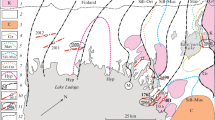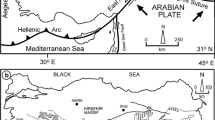Abstract
Multi-period of pseudotachylytes of variable occurrences and shapes are widely outcropped in Haizikou and Mukurasen sections of the Koktokay-Ertai fault zone. They consist of clasts and matrix. The clasts comprise fine fragments of the host rock (mylonite) and quartz grains, while the matrix consists of cryptocrystalline and glassy materials which contain fibrous and radial microlites. The chemical compositions of the pseudotachylytes resemble those of the host rocks. Their features indicate that the pseudotachylytes were formed from local melting of the mylonites during the rapid movement of the fault, and that the formation depth was 10—12 km. The geologic event that produced pseudotachylytes is believed to be paleoearthquake.
Similar content being viewed by others
References
Spray, J. G., Friction phenomena in rocks: an introduction,J Struc Geol, 1989, 11:783.
Sibson, R. H., Earthquake faulting as a structural process,J Struc Geol, 1989, 11:1.
Lin Chuanyong, Fan Futian, Microstructural analysis of Fuyun fault Zone, Xinjiang, China,J Seismological (in Chinese), 1984, 1: 1.
Lin Aimin, Glassy pseudotachylyte veins from the Fuyun fault zone, northwest China,Struc Geol, 1994, 16:71.
Lin Aimin, Microlite morphology and chemistry in pseudotachylyte from the Fuyun fault zone,Ginese Geol, 1994, 102:317.
Ge Shumo, Bai Meixiang, Zheng Fuwanet al., The active Koktokay-Ertai fault zone,Aths of Active Faults in China (ed. Working Group of the Project 206), Beijing: Seismological Press, 1989, 105–108.
Seismological Bureau of Xinjiang Uygur Autonomous Region,The Fuyun Seismic Fault Zone (in Chinese), Beijing: Seismological Press, 1989, 206.
Magloughlin, J. F., Nature and significance of pseudotachylytes from the Nasson Terrane, North Cascade Mountains, Washington,J Struc Geol, 1989, 11:907.
Magloughlin, J. F., Spray, J. G., Frictional melting processes and products in geological materials: introduction and discussion,Tectonophys, 1992, 204:197.
Swanson, M. T., Pseudotachylyte bearing strike slip duplex structure in the Fort Foster Brittle Zone of Southern Maine,J Struc Geol, 1988, 10:289.
Koch, N., Masch, L., Formation of Alpine mylonites and pseudotachylytes at the base of the Silvretta Nappe, eastern Alps,Tectonophysi 1992, 204:289.
Strehlau, J. A., Discussion of the depth extent of rupture in large continental earthquakes; inEarthquake Source Mechanics, Am Geophy Unions Monogr (eds. Das, S., Spray, G., Scholz, C.), Vol. 37 (Maurice Ewing V 6), 131–145
Author information
Authors and Affiliations
Additional information
Project supported by the Joint Earthquake Science Foundation.
Rights and permissions
About this article
Cite this article
Shi, L., Lin, C., Zhang, X. et al. Pseudotachylytes from the Koktokay-Ertai fault zone, Xinjiang, China, and their seismogeologic implications. Sci. China Ser. D-Earth Sci. 40, 189–196 (1997). https://doi.org/10.1007/BF02878378
Received:
Issue Date:
DOI: https://doi.org/10.1007/BF02878378




